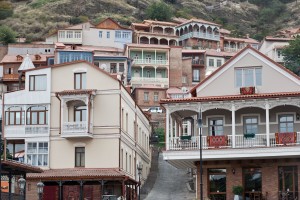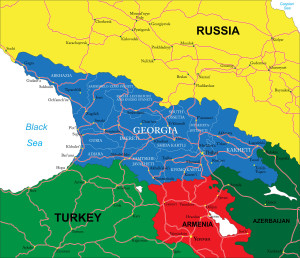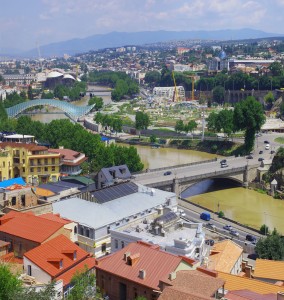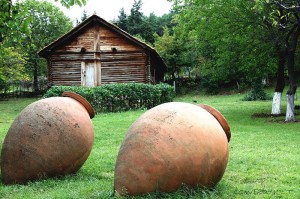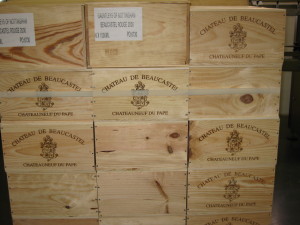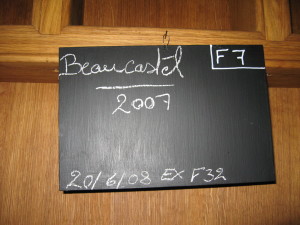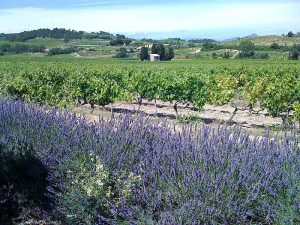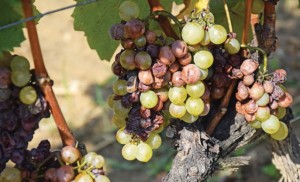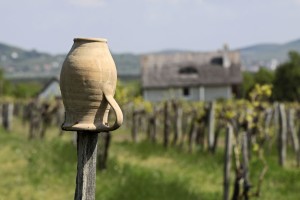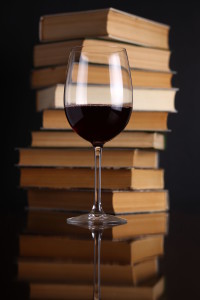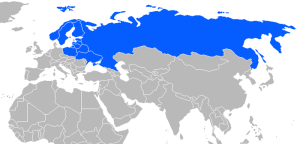Today we have a guest post from renowned Wine and Spirits Educator Harriet Lembeck. Read on to hear about Harriet’s recent wine trip to the Republic of Georgia!
If you really care about wine, you should think seriously about making the journey to the country of Georgia. You will experience true hospitality, tradition, wine-making, and still be close enough to the Black Sea’s famed resorts when you are ready to relax. And if you like to ski, there are the slopes of the Caucasus Mountains right there as well.
FYI, I have just returned from a visit, and saw no sign of any of the unrest that’s been in the news lately. There is instead a sense of calm and welcoming.
To the Georgians, a guest is a gift from God. And the best way to greet a guest is to serve one’s own wine, made from one’s own grapes. No patch of land goes vacant, and grapes grow on what elsewhere might be a lawn. Further, every home winemaker has a still, and he will also pour you his clear pomace brandy, or Chacha.
If you go to a Georgian banquet, dishes will be continually placed on the table, and nothing will be cleared until the end — in case the guest might want a little more of anything! Walnuts are the preferred stuffing for confections, fruits, vegetables and even boned fish. Meals are leavened with toasts. The toastmaster shows gratitude for the Creator, for food, for friendships, for all the women, for beauty, for love, for people who have passed away, and for the children looking to the future.
Historical Significance
Georgia is referred to as the “Cradle of Wine,” as wine has been made there continuously for the last 8,000 years (The Georgians say “8,000 Vintages”). There was very early winemaking in Greece, Cyprus, Turkey, Crimea, Armenia and Moldava, but all evidence points to at least 6,000 BCE, if not before, for the first propagation of wine grapes — in Georgia — in the Fertile Crescent.
Records show 525 grape varieties, including clones, of which 440 are still in use. Do not despair — even if you go there and taste a lot of wines, you are not likely to come across more than twenty, if that many. The white Rkatsiteli and the red Saperavi are the most prevalent, but you may see some international varieties as well.
Historically, this tradition was interrupted for about seventy years, when Russia took over between 1921 and 1991. The Russians knew that banning the production of wine was hopeless in Georgia. “Georgia is synonymous with wine,” it is said. But with wine permitted, the Russians were more interested in high volume than in quality, and after three generations, much of the fine wine tradition was lost. Many of today’s winemakers are now working to restore it.
There are 10 main wine regions in Georgia, which contain 18 smaller Protected Denominations of Origin (PDOs). The majority of wineries and growers are in the Kakheti Valley, very close to Tbilisi. Going from east to west, you will pass through Imereti and other central and western wine regions. Summers are hot, but spring or fall are perfect times to visit.
Your first stop should be Tbilisi, and once there, you should go to the Vino Underground Wine Bar, which has the largest selection of organic and/or “bio” Georgian wines. Also go to the Azarpesha Wine Restaurant, named for a long-handled drinking bowl, for a traditional meal. You may meet partner and ex-pat American John Wurdeman in either place. He is an articulate moving force in reclaiming Georgian traditions in wine, food, polyphonic music and dance, and is also the founder of Pheasant’s Tears Winery.
All About Qvervis
Wine has been traditionally fermented and aged in qvevris (kvevris), or large clay pots that are bur ied in the earth. They are shaped something like Roman amphorae, but the amphorae re- main above ground. When people buy older houses, it is not unusual to lift up the floor- boards and find buried qvevris below. Many winemakers are using qvevris now, though some do use stainless steel or oak barrels, and some use both. To learn about qvevris, you should not miss a visit to Twins Old Cellar in Napareuli Village in the Telavi district. I dubbed it “Qvevri School.” The twin brothers have set up an oversized qvevri display to honor their parents.
Previously, the Soviets had taken over their winery, and their father died in prison. The property was eventually returned. They have made an outdoor room-sized qvevri, reached by a ladder. Once inside, you feel as if you are standing in an enormous qvevri. The clay walls are marked showing levels of internal activity as a wine ages and solids reach the
bottom of this curve-sided vessel. The twins have 107 qvevris in use, restoring a tradition that was almost lost. [Note: Besides creating a wine museum, they also have a dozen guest rooms, should you decide to visit and stay over.] With renewed interest in ovoid, clay fermenters, some qvevris are being produced in the United States. A Texan, Billy Ray Mangham of Sleeping Dog Pottery and his team, have a “Qvevri Project.” Andrew Beckham, a potter and winemaker in Oregon has his own “Amphorae Project.” Also, a potter on the outskirts of Austria is now making qvevris. Further, there is increased experimentation with ‘the concrete egg’ – concrete egg-shaped tanks made in Burgundy. The Emiliana Vineyards, from Chile, has made a very big investment in them for their winery in Casablanca.
Among other sites, concrete eggs are used in the Glenora Winery, the first Farm Winery in the Finger Lakes, NY. In 2013, UNESCO recognized qvevris and qvevri-winemaking, and placed them on the “Representative List of the Intangible Cultural Heritage of Humanity.” Qvevris last for a very long time. They are not discarded when they are no longer useful, but are respectfully leaned against garden walls.
Inspired to visit? Click here to download some Tips for a Successful Wine Trip to the Republic of Georgia from Harriet Lembeck
 HARRIET LEMBECK, CWE, CSS, is a prominent wine and spirits educator. She is president of the renowned Wine & Spirits Program, and revised and updated the textbook Grossman’s Guide to Wines, Beers and Spirits. She was the Director of the Wine Department for The New School University for 18 years. She may be contacted at hlembeck@mindspring.com.
HARRIET LEMBECK, CWE, CSS, is a prominent wine and spirits educator. She is president of the renowned Wine & Spirits Program, and revised and updated the textbook Grossman’s Guide to Wines, Beers and Spirits. She was the Director of the Wine Department for The New School University for 18 years. She may be contacted at hlembeck@mindspring.com.
This article was originally published in the article was originally published in
Beverage Dynamics Magazine – reprinted with permission!
Are you interested in being a guest blogger or a guest SWEbinar presenter for SWE? Click here for more information!
